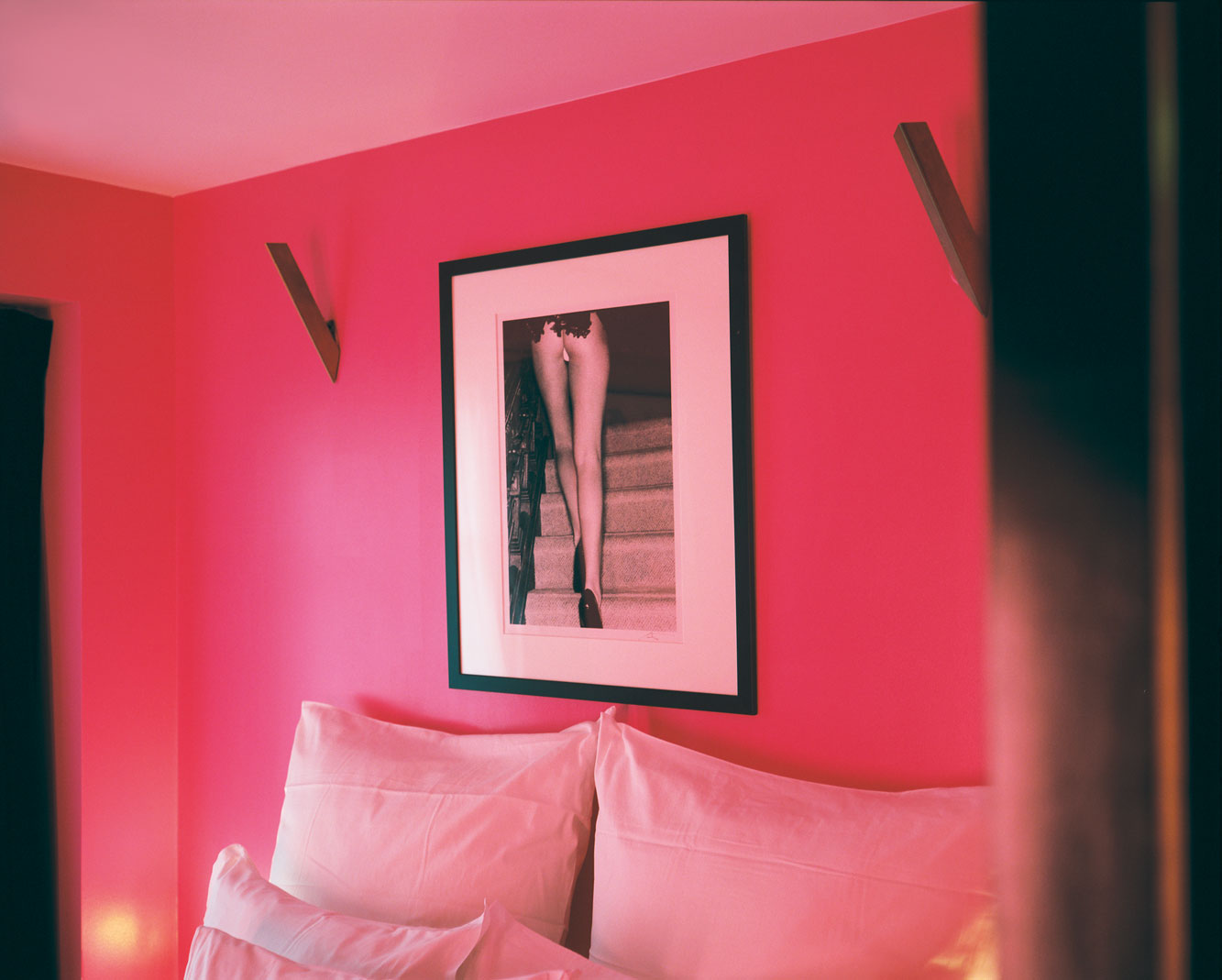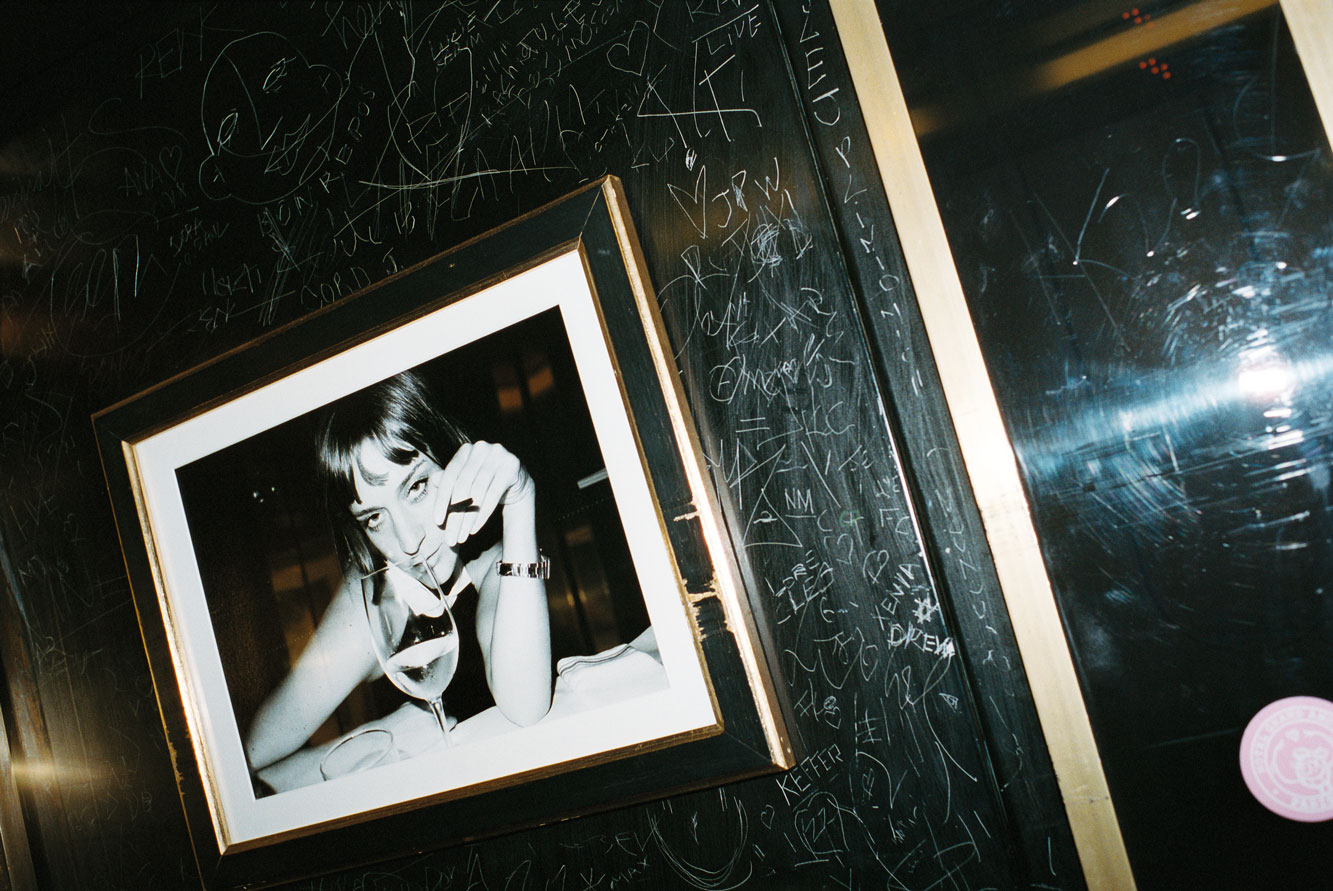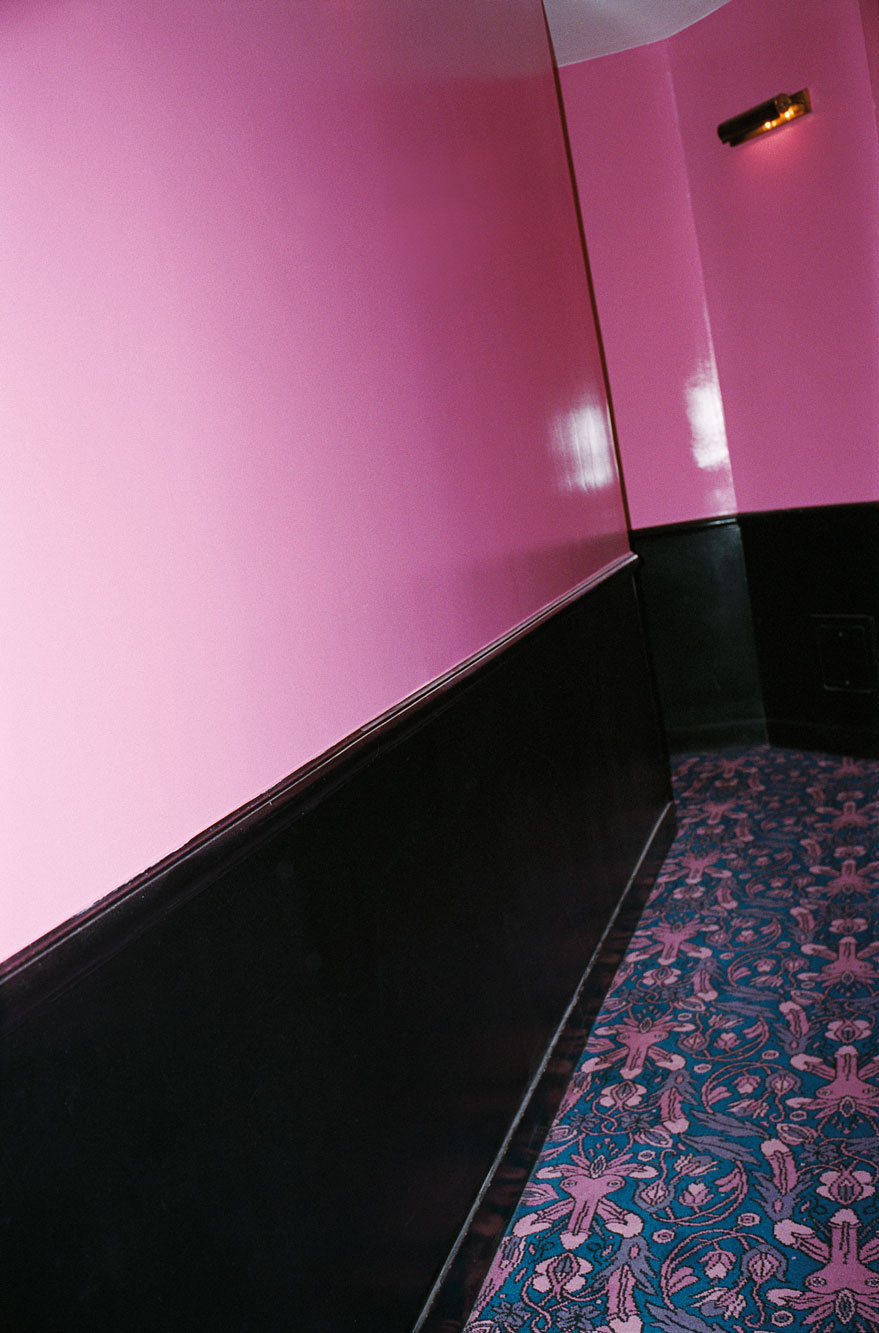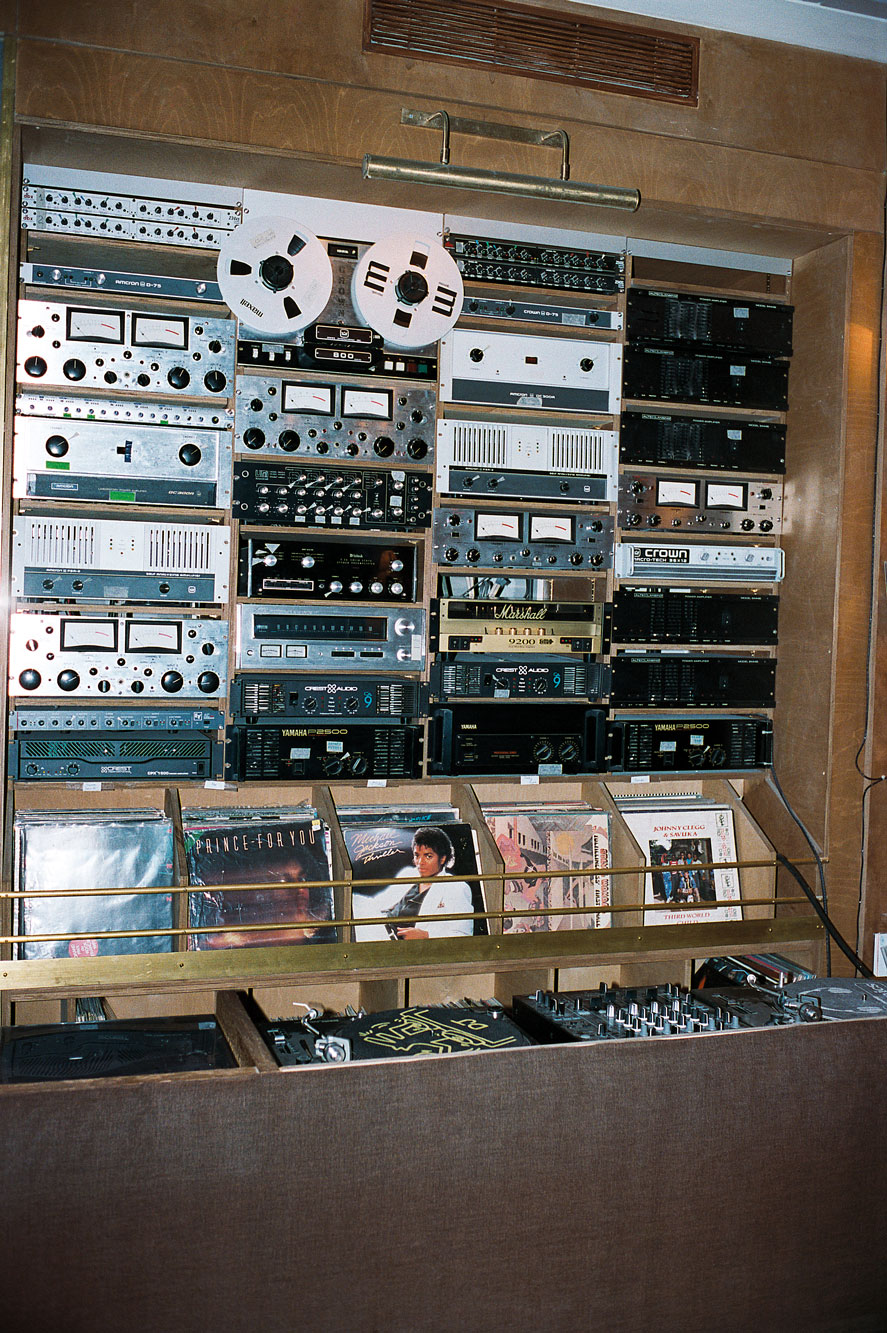Purple Magazine
— The Paris Issue #31 S/S 2019
hôtel grand amour/andré
andré
interview and photography by OLIVIER ZAHM
hôtel grand amour is not just a place for checking
in and checking out. it’s not a club, but it could
be. it’s what paris used to be famous for, a place
for romance
OLIVIER ZAHM — Did you have an ideal hotel in mind, a model?
ANDRÉ — I didn’t know the Chelsea in its heyday, but it’s clear I was thinking of that mythical hotel and recreating something like that on a small scale, with 24 tiny little rooms. All our artist friends from New York have been here. Dash Snow, for example. I remember when you spent the day interviewing him in his room, naked, with his girlfriend Jade, who was pregnant… My Amour hotels are not a chain. They’re not concept hotels, either, or boutique hotels, or hotels done up by hip designers. This is an artists’ hotel, made for a creative community coming together. I want people to feel at home. You won’t get chucked out of your room if you haven’t checked out in time. You won’t be shouted at if you smoke, even if it is, of course, forbidden, or if you screw all night. Sometimes, friends who are hard up leave without paying, and sometimes there are those who can afford to pay for others. And besides, it was created by real Parisians:
you won’t find many hotels nowadays where the bosses live and eat every day.
OLIVIER ZAHM — What is a good hotel for you?
ANDRÉ — It’s a place that is like home, where you don’t feel like a tourist who’s just passing through, where right away you feel part of the city. That’s very rare — very few hotels have that. Most hoteliers just sell beds to sleep in. Before André Balazs came along with the Standard Hotel in New York and now the Chiltern Firehouse in London, and soon, in the Rue des Saint-Pères in Paris, no one thought a hotelier could be cool and sexy. Yes, there were the boutique hotels, the Hôtel Costes, which was more chic, and the more fun Bowery Hotel in New York — they’re everywhere now. But a hotel for a real creative community did not exist. Paris deserved to have one. And I think this is where it’s happening.
OLIVIER ZAHM — So, it’s like being welcomed into a family?
ANDRÉ — Yes, the people here seem like family. A creative family.
OLIVIER ZAHM — As someone who’s always traveling, what is your favorite hotel?
ANDRÉ — I love the Ritz in Lisbon. My city… My favorite hotel in the entire world has to be the Colombe d’Or in Saint-Paul-de-Vence. A hotel still run by the Roux family, who refuse to be bought by the hotel groups. It’s a totally magical place because there were all those artists who lived there and left sublime works, starting with Picasso, Yves Klein, the ceramic wall by Fernand Léger on the terrace, the swimming pool mosaics by Max Ernst, paintings by Joan Miró, Marc Chagall, Henri Matisse, and the mobile by Alexander Calder over the swimming pool, the thumb by César at the entrance… It’s magical, but I’m not sure it’s still like that today.
OLIVIER ZAHM — Yes, but the decor is still there. There’s even a big model by Jean Nouvel in the dining room. And it’s still a very erotic place. There’s nothing sexier than sleeping in a bedroom with a real canvas.
ANDRÉ — The decor is there. The mythic works are, too. But there’s more to a hotel than the decor. There are no longer any artists putting new works on the wall, whereas here they still are, all the time! The Colombe is nostalgia. It’s one of the chicest places. But there’s a lot of nostalgia, and here we try not to be nostalgic.
OLIVIER ZAHM — You keep changing the place?
ANDRÉ — All the time! There is no fixed concept — it’s constantly evolving. Even today, we’re in the process of redoing rooms. Samuel Boutruche, formerly of Kolkoz, has made a room in a voyeuristic, Duchampian spirit, à la Given. The day before yesterday, Emmanuel Delavenne and I decided that we would repaint everything and rebuild damaged furniture. As soon as we get a bit of money, we do something new. Also, we’re going to add a floor to the Hôtel Amour. We’re creating three or four artists’ studios on the top floor! With a glass ceiling. Very bright rooms with good high ceilings. It will be very Parisian, very “bohemian” — if that word isn’t too ridiculous.
OLIVIER ZAHM — You do have a nostalgic side, though, in your passion for black-and-white.
ANDRÉ — Yes, I have a lot of photos by my friend Olivier Zahm [laughs], who also made a very “sexy” room. And I even had to hold you back about those S-M accessories integrated into the furniture.
OLIVIER ZAHM — In the two Hôtels Amour, you get artists or people you like to do the rooms.
ANDRÉ — A lot of people have made rooms. A lot of people have given things. At the Hôtel Amour, Alexandre de Betak made a really fun room: he put lots of disco balls on the ceiling — we had to put in a hundred little motors to make these balls rotate. When they do spin, with the spotlights on them, it’s like a sea of reflections. Very beautiful. At the Grand Amour, there is a brilliant room by the French conceptual artist Claude Rutault. He made a room with monochrome paintings on the floor, a faded pink color, the same color as the walls. When you move in, you can hang them wherever you like, juxtapose them, compose your own room. Everyone who sleeps there makes their room anew.
OLIVIER ZAHM — Are you going to make that room planned by our friend, the writer and art critic Glenn O’Brien?
ANDRÉ — We are going to do it, yes. Sadly, he died just when he was about to finish his room, but he sent me a list of what he wanted. He wanted two Hermes Baby typewriters, one with an American keyboard and one with a French keyboard, his books, and a little campaign desk.
OLIVIER ZAHM — And then, there’s the giant birdcage by Carsten Höller.
ANDRÉ — Recently, Carsten Höller designed a mobile, a birdcage in which he will put two little singing birds, two castrated birds, which sing louder than others. It’s a very bulky work that’s the size of the well in the courtyard. It moves — it’s like a big mobile composed of two cages in the form of planets orbiting each other. It’s a very fine work, but not a decorative one, on the theme of amorous song.
OLIVIER ZAHM — Now, people are fighting to get a room with you.
ANDRÉ — It’s always full. We try not to be too selective, and it’s not very expensive.
OLIVIER ZAHM — Because you also manage to do something that is very Parisian, in my view, something romantic.
ANDRÉ — Paris is all about encounters. Often, when you go to a hotel, usually you’re reluctant to go up to your room. Here, people hang around in the hotel, in the bar, in the restaurant, in the courtyard, in the library. It’s not a club, but it’s like one. We don’t have TV — we never did. That means we don’t get those people who want a TV. But we do have books in all the rooms, magazines, and all the newspapers that arrive downstairs in the morning.
OLIVIER ZAHM — And on the weekend, maybe even in the week, there is that hint of clubbing.
ANDRÉ — We wanted to make a hotel that was open to the city, for Parisians, as well — where you can come and eat, listen to music, have meetings, be with friends… And all that suddenly adds up to a place where you can really live. Intellectually stimulating. And above all, no spa! So boring. And no gym. [Laughs] It’s a Parisian place!
OLIVIER ZAHM — But what is so Parisian about it, in your view?
ANDRÉ — Just the words: “Amour,” “Grand Amour,” that’s very Parisian. We recognize our freedom, our sexuality. Endless discussion. Wasting time. The taste for art more than for decoration.
OLIVIER ZAHM — That little edge of resistance…
ANDRÉ — There’s a bit of resistance in the age of obligatory profitability. We don’t do everything for money. We chose to create a place that we’re truly proud of, that people who come here feel close to.
OLIVIER ZAHM — What is the story of the first Hôtel Amour behind Pigalle, which you created with Emmanuel Delavenne over 10 years ago now?
ANDRÉ — The artist Rirkrit Tiravanija had organized a dinner at Thierry Costes’s place in Paris. Also, there were Mathias Augustyniak and Michael Amzalag of M/M, the artist Philippe Parreno, the gallerist Edouard Merino, and others. This was the time when my nightclub Le Baron was doing well. I put out the idea of a hotel in Paris for artists. Thierry said: “My uncle has a little hôtel de passe [hotel used by prostitutes] in Pigalle. He wants to sell.” I said, “Let’s all buy it together!” Everyone was up for it! We all ended the dinner dreaming of this new project. Except that the next day, when we had to meet up again to take action, everyone had sobered up and got cold feet. Leaving only Thierry and me.
OLIVIER ZAHM — Because it also meant stumping up…
ANDRÉ — Because you had to stump up and also because it was work! In those days, cool people didn’t do hotels. In France, anyway, it wasn’t something that excited people. So, there were the two of us, and Thierry said: “I’ve got this really good childhood friend, Emmanuel Delavenne. He’s interested in being involved.” So, the three of us decided to buy this little hotel in the Rue Navarin. To raise the money to buy it and have work done. Fairly soon, I was living there. Our friend, the actor Melvil Poupaud, was one of the first people to live there, too.
OLIVIER ZAHM — Was the name your idea?
ANDRÉ — That old hôtel de passe was called Le Navarin, after the street. It wasn’t what you would call sexy, and in those days the neighborhood wasn’t really chic. It was the bottom end of Pigalle. It wasn’t trendy like it is today. But this quarter has always been the love district — love for sale, maybe, but still love. It also comes from my love of Japan, the love hotels in Tokyo. The name came in a flash. And I immediately worked up the image with my drawings and my writing. In fact, I’ve just finished a huge ceramic wall for the Hôtel Grand Amour with a Mr. A jumping all the way up to the last floor.
OLIVIER ZAHM — About 2008, that’s when Le Baron, which you created with Lionel Bensemoun, was really hot. The night scene was really fun.
ANDRÉ — It was fun. It was free. We didn’t charge friends at the bar. You yourself never paid for a drink at Le Baron. But we didn’t have anywhere for people to sleep, to put up our artist friends from around the world. So, creating a hotel was a logical step. That was when we opened the Beatrice, the club in New York with you and Paul Sevigny and other friends. I was always heading off to New York — you and I used to meet there all the time. This was also when I decided to give up my Parisian apartment, which was costing me too much. That came at a good time, in fact, because we didn’t have enough furniture to put in our hotel, so I put all my furniture and my things in the hotel.
OLIVIER ZAHM — Your magazines, all your furniture, and your artworks… So, it was like it was your own place. You must have had a lot of things stolen, too?
ANDRÉ — People stole things — all my magazines, signed photographs.
OLIVIER ZAHM — How did you envisage the decoration?
ANDRÉ — I didn’t want a concept hotel or a design hotel. I spent a lot of time going around the flea markets with Emmanuel — buying furniture, lamps, sconces, and vases — and also the auction house Drouot, and lots of books, too. Good books. We didn’t want to do a conceptual project, or a decorators’ hotel, but simply to make a place that was alive, as if it were for ourselves. We made lots of bedrooms with their own bookcases full of books, objects of all kinds. It was a blast! We used lots of black and lacquered pink — it was my black and pink period. [Laughter] We got hold of the old chairs from the Café Costes. And because I didn’t have much money, it wasn’t all ready for the opening! At first, in most of the rooms, there was almost nothing, and gradually we got around to furnishing them. We were the first to put in lots of things by Memphis, by Ettore Sottsass.
OLIVIER ZAHM — Another important thing: the photos in the hotel. From the outset, you wanted real works of art.
ANDRÉ — Yes, not fake stuff. Signed photos by Pierre Molinier, by Juergen Teller, by Guy Bourdin, and by yourself, too. Dash Snow came and gave me a huge photo.
OLIVIER ZAHM — And for the restaurant?
ANDRÉ — Emmanuel, my partner, is crazy about food, and he made sure we had a little bistro. We were among the first to have natural wines and traceable products.
OLIVIER ZAHM — And now the Hôtel Amour is a success, and you’re opening the Grand Amour, which is more ambitious, but in the same spirit.
ANDRÉ — A bit more ambitious, but we’re not trying to be more luxurious or more expensive. That doesn’t interest us. It’s just that with the Amour, we were always full. We wanted to develop the same ideas on a bigger scale. The only difference is that we have 10 years of experience behind us. So, at the Grand Amour, the hotel is bigger, the restaurant is bigger, and there are more rooms, about 40. The kitchen at the Hôtel Amour is the size of a cupboard, whereas here, at the Grand Amour, the whole basement is a restaurant, which Emmanuel conceived for high dining, Parisian style. A place where the best chefs can really let themselves go.
OLIVIER ZAHM — And you’ve extended the hotel by taking over an old garage next door and converting it into a bar, with a vintage sound system.
ANDRÉ — We call it the Book Bar because we’ve put in lots of books — again, I filled it up from my library and with secondhand finds. I’m talking about interesting books, not decorative books! And we have got this vinyl sound with top-quality decks and studio speakers. Three magnificent JBL speakers found for us by our collector friend, who did the decoration.
OLIVIER ZAHM — So, your hotel is like your home. You do it up as if it were your own apartment.
ANDRÉ — In a way, it has become a home to me. Ever since I gave up my apartment in Paris for my loft in Chinatown, New York, I’ve always lived in the Amour. It’s been 10 years. Even today, I’m still in one of the rooms.
END
 HÔTEL GRAND AMOUR, FRAMED PHOTOGRAPH COPYRIGHT TONY WARD
HÔTEL GRAND AMOUR, FRAMED PHOTOGRAPH COPYRIGHT TONY WARD
 JAPANESE MOVIE POSTER OF LA JETÉE BY CHRIS MARKER, 1962
JAPANESE MOVIE POSTER OF LA JETÉE BY CHRIS MARKER, 1962
 PORTRAIT OF CHLOË SEVIGNY IN THE ELEVATOR SHOT BY OLIVIER ZAHM AT THE WAVERLY INN, NEW YORK, 2011
PORTRAIT OF CHLOË SEVIGNY IN THE ELEVATOR SHOT BY OLIVIER ZAHM AT THE WAVERLY INN, NEW YORK, 2011
 SOUND SYSTEM JBL/BRAUN SPEAKERS, INSTALLED BY YVES COUCHAUD IN THE BOOK BAR
SOUND SYSTEM JBL/BRAUN SPEAKERS, INSTALLED BY YVES COUCHAUD IN THE BOOK BAR
 CARPET IN THE CORRIDORS DESIGNED BY ANDRÉ SARAIVA AND PIERRE FREY
CARPET IN THE CORRIDORS DESIGNED BY ANDRÉ SARAIVA AND PIERRE FREY
 ROOM 304 DESIGNED BY OLIVIER ZAHM WITH HIS PHOTOS
ROOM 304 DESIGNED BY OLIVIER ZAHM WITH HIS PHOTOS
 A SCULPTURE MADE WITH TWO BIRDS AND TWO CAGES FOR THE COURTYARD OF THE HOTEL BY CARSTEN HÖLLER, CIRCLE DIVISION CANARY MOBILE (BLACK OUTSIDE, WHITE INSIDE), 2018, COURTESY OF THE ARTIST, COPYRIGHT ADAGP, PARIS, 2019
A SCULPTURE MADE WITH TWO BIRDS AND TWO CAGES FOR THE COURTYARD OF THE HOTEL BY CARSTEN HÖLLER, CIRCLE DIVISION CANARY MOBILE (BLACK OUTSIDE, WHITE INSIDE), 2018, COURTESY OF THE ARTIST, COPYRIGHT ADAGP, PARIS, 2019




















































































































































































































